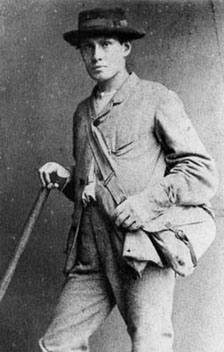| Edward Whymper  Born: 27-Apr-1840 Born: 27-Apr-1840
Birthplace: London, England
Died: 16-Sep-1911
Location of death: Chamonix, France
Cause of death: unspecified
Gender: Male
Race or Ethnicity: White
Occupation: Explorer, Engraver Nationality: England
Executive summary: Scrambles among the Alps British artist, explorer and mountaineer, born in London on the 27th of April 1840. The son of an artist, he was at an early age trained to the profession of a wood engraver. In 1860 he was commissioned to make a series of sketches of Alpine scenery, and undertook an extensive journey in the Central and Western Alps. Among the objects of this tour was the illustration of an attempt, which proved unsuccesful, made by Professor Bonney's party, to ascend Mont Pelvoux, at that time believed to be the highest peak of the Dauphin Alps. He successfully accomplished the ascent in 1861 -- the first of a series of expeditions that threw much light on the topography of a district at that time very imperfectly mapped. From the summit of Mont Pelvoux he discovered that it was overtopped by a neighboring peak, subsequently named the Pointe des Écrins, which, before the annexation of Savoy added Mont Blanc to the possessions of France, was the highest point in the French Alps. Its ascent by Whymper's party in 1864 was perhaps the most remarkable feat of mountaineering up to that date. The years 1861 to 1865 are filled with a number of new expeditions in the Mont Blanc group and the Pennine Alps, among them the ascent of the Aiguille Verte and the crossing of the Morning Pass. Professor Tyndall and Whymper emulated each other in fruitless attempts to reach the summit of the Matterhorn by the southwestern or Italian ridge. Whymper, six times repulsed, determined to try the eastern face, convinced that its precipitous appearance when viewed from Zermatt was an optical illusion, and that the dip of the strata, which on the Italian side formed a continuous series of overhangs, should make the opposite side a natural staircase. His attempt by what is now the usual route was crowned with success (14th of July 1865); but on the descent four of the party slipped and were killed, and only the breaking of the rope saved Whymper and the two remaining guides from the same fate. The account of his attempts on the Matterhorn occupies the greater part of his Scrambles among the Alps (1871), in which the illustrations are engraved by the author himself, and are very beautiful. His campaign of 1865 had been planned to exercise his judgment in the choice of routes as a preparation for an expedition to Greenland (1867). This resulted in an important collection of fossil plants, which were described by Professor Heer and deposited in the British Museum. Whymper's report was published in the Report of the British Association for the year 1869. Though hampered by want of means and by the prevalence of an epidemic among the natives, he proved that the interior could be explored by the use of suitably constructed sledges, and thus contributed an important advance to Arctic exploration. Another expedition followed in 1872, and was devoted to a survey of the coastline. He next organized an expedition to Ecuador, designed primarily to collect data for the study of mountain sickness and of the effect of diminished pressure on the human frame. He took as his chief guide Jean-Antoine Carrel, whose subsequent death from exhaustion on the Matterhorn after bringing his employers into safety through a snowstorm forms one of the noblest pages in the history of mountaineering. During 1880 Whymper on two occasions ascended Chimborazo, whose summit, 20,500 feet above sea-level, had never before been reached; spent a night on the summit of Cotopaxi, and made first ascents of half-a-dozen other great peaks. In 1892 he published the results of his journey in a volume, entitled Travels amongst the Great Andes of the Equator. His observations on mountain sickness led him to conclude that it was caused by "diminution in atmospheric pressure, which operates in at least two ways -- namely, (a) by lessening the value of the air that can be inspired in any given time, and (b) by causing the air or gas within the body to expand, and to press upon the internal organs"; and that "the effects produced by (b) may be temporary and pass away when equilibrium has been restored between the internal and external pressure." The publication of his work was recognized on the part of the Royal Geographical Society by the award of the Patron's medal. His experiences in South America having convinced him of certain serious errors in the readings of aneroid barometers at high altitudes, he published a work, entitled How to Use the Aneroid Barometer, and succeeded in introducing important improvements in their construction. He afterwards published two guidebooks to Zermatt and Chamonix. In 1901-05 he undertook his final expeditions in the region of the Great Divide of the Canadian Rockies.
Do you know something we don't?
Submit a correction or make a comment about this profile
Copyright ©2019 Soylent Communications
|